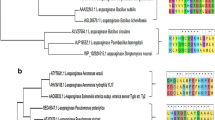Abstract
Enzyme I (EI) of the bacterial phosphotransferase system (PTS) utilizes phosphoenolpyruvate (PEP) as a source of energy in order to transport sugars across the cellular membrane. PEP binding to EI initiates a phosphorylation cascade that regulates a variety of essential pathways in the metabolism of bacterial cells. Given its central role in controlling bacterial metabolism, EI has been often suggested as a good target for antimicrobial research. Here, we report the 1HN, 15N, 13C′, 1Hmethyl, and 13Cmethyl chemical shifts of the 128 kDa homodimer EI from the thermophile Thermoanaerobacter tengcongensis. In total 79% of the expected backbone amide correlations and 80% of the expected methyl TROSY peaks from U-[2H, 13C, 15N], Ileδ1-[13CH3], Val-Leu-[13CH3/12CD3] labeled EI were assigned. The reported assignments will enable future structural studies aimed at illuminating the fundamental mechanisms governing long-range interdomain communication in EI and at indicating new therapeutic strategies to combat bacterial infections.





Similar content being viewed by others
References
Chauvin F, Brand L, Roseman S (1996) Enzyme I: the first protein and potential regulator of the bacterial phosphoenolpyruvate: glycose phosphotransferase system. Res Microbiol 147:471–479
Clore GM, Gronenborn AM (1998) Determining the structures of large proteins and protein complexes by NMR. Trends Biotechnol 16:22–34
Clore GM, Venditti V (2013) Structure, dynamics and biophysics of the cytoplasmic protein-protein complexes of the bacterial phosphoenolpyruvate: sugar phosphotransferase system. Trends Biochem Sci 38:515–530. https://doi.org/10.1016/j.tibs.2013.08.003
Delaglio F, Grzesiek S, Vuister GW, Zhu G, Pfeifer J, Bax A (1995) NMRPipe: a multidimensional spectral processing system based on UNIX pipes. J Biomol NMR 6:277–293
Deutscher J et al (2014) The bacterial phosphoenolpyruvate:carbohydrate phosphotransferase system: regulation by protein phosphorylation and phosphorylation-dependent protein-protein interactions. Microbiol Mol Biol Rev 78:231–256. https://doi.org/10.1128/MMBR.00001-14
Dotas RR, Venditti V (2017) (1)H, (15)N, (13)C backbone resonance assignment of the C-terminal domain of enzyme I from Thermoanaerobacter tengcongensis. Biomol NMR Assign 12(1):103–106. https://doi.org/10.1007/s12104-017-9788-x
Evangelidis T et al (2018) Automated NMR resonance assignments and structure determination using a minimal set of 4D spectra. Nat Commun 9:384. https://doi.org/10.1038/s41467-017-02592-z
Navdaeva V et al (2011) Phosphoenolpyruvate: sugar phosphotransferase system from the hyperthermophilic Thermoanaerobacter tengcongensis. Biochemistry 50:1184–1193
Nguyen TT, Ghirlando R, Venditti V (2018) The oligomerization state of bacterial enzyme I (EI) determines EI’s allosteric stimulation or competitive inhibition by alpha-ketoglutarate. J Biol Chem 293(7):2631–2639. https://doi.org/10.1074/jbc.ra117.001466
Oberholzer AE, Bumann M, Schneider P, Bachler C, Siebold C, Baumann U, Erni B (2005) Crystal structure of the phosphoenolpyruvate-binding enzyme I-domain from the Thermoanaerobacter tengcongensis PEP: sugar phosphotransferase system (PTS). J Mol Biol 346:521–532
Patel HV, Vyas KA, Mattoo RL, Southworth M, Perler FB, Comb D, Roseman S (2006) Properties of the C-terminal domain of enzyme I of the Escherichia coli phosphotransferase system. J Biol Chem 281:17579–17587. https://doi.org/10.1074/jbc.M508966200
Pervushin K, Riek R, Wider G, Wuthrich K (1997) Attenuated T2 relaxation by mutual cancellation of dipole-dipole coupling and chemical shift anisotropy indicates an avenue to NMR structures of very large biological macromolecules in solution. Proc Natl Acad Sci USA 94:12366–12371
Postma PW, Lengeler JW, Jacobson GR (1996) Phosphoenolpyruvate: Carbohydrate Phosphotransferase Systems. In: Neidhardt FC, Lin EC, Curtiss R (eds) Escherichia coli and Salmonella: cellular and molecular biology. ASM, Washington, pp 1149–1174
Schwieters CD, Suh JY, Grishaev A, Ghirlando R, Takayama Y, Clore GM (2010) Solution structure of the 128 kDa enzyme I dimer from Escherichia coli and its 146 kDa complex with HPr using residual dipolar couplings and small- and wide-angle X-ray scattering. J Am Chem Soc 132:13026–13045
Teplyakov A et al (2006) Structure of phosphorylated enzyme I, the phosphoenolpyruvate: sugar phosphotransferase system sugar translocation signal protein. Proc Natl Acad Sci USA 103:16218–16223
Tugarinov V, Kay LE (2003) Ile, Leu, and Val methyl assignments of the 723-residue malate synthase G using a new labeling strategy and novel NMR methods. J Am Chem Soc 125:13868–13878. https://doi.org/10.1021/ja030345s
Tugarinov V, Hwang PM, Ollerenshaw JE, Kay LE (2003) Cross-correlated relaxation enhanced 1H[bond]13C NMR spectroscopy of methyl groups in very high molecular weight proteins and protein complexes. J Am Chem Soc 125:10420–10428. https://doi.org/10.1021/ja030153x
Tugarinov V, Kanelis V, Kay LE (2006) Isotope labeling strategies for the study of high-molecular-weight proteins by solution NMR spectroscopy. Nat Protoc 1:749–754. https://doi.org/10.1038/nprot.2006.101
Tugarinov V, Venditti V, Marius Clore G (2014) A NMR experiment for simultaneous correlations of valine and leucine/isoleucine methyls with carbonyl chemical shifts in proteins. J Biomol NMR 58:1–8. https://doi.org/10.1007/s10858-013-9803-1
Ulrich EL et al (2008) BioMagResBank. Nucleic Acids Res 36:D402–D408. https://doi.org/10.1093/nar/gkm957
Venditti V, Clore GM (2012) Conformational selection and substrate binding regulate the monomer/dimer equilibrium of the C-terminal domain of Escherichia coli enzyme I. J Biol Chem 287:26989–26998. https://doi.org/10.1074/jbc.M112.382291
Venditti V, Fawzi NL, Clore GM (2011) Automated sequence- and stereo-specific assignment of methyl-labeled proteins by paramagnetic relaxation and methyl-methyl nuclear Overhauser enhancement spectroscopy. J Biomol NMR 51:319–328. https://doi.org/10.1007/s10858-011-9559-4
Venditti V, Ghirlando R, Clore GM (2013) Structural basis for enzyme I inhibition by alpha-ketoglutarate. ACS Chem Biol 8:1232–1240. https://doi.org/10.1021/cb400027q
Venditti V, Schwieters CD, Grishaev A, Clore GM (2015a) Dynamic equilibrium between closed and partially closed states of the bacterial Enzyme I unveiled by solution NMR and X-ray scattering. Proc Natl Acad Sci USA 112:11565–11570. https://doi.org/10.1073/pnas.1515366112
Venditti V, Tugarinov V, Schwieters CD, Grishaev A, Clore GM (2015b) Large interdomain rearrangement triggered by suppression of micro- to millisecond dynamics in bacterial Enzyme I. Nat Commun 6:5960. https://doi.org/10.1038/ncomms6960
Acknowledgements
This work was supported by funds from the Roy J. Carver Charitable Trust and Iowa State University (to V.V.).
Author information
Authors and Affiliations
Corresponding author
Additional information
Publisher's Note
Springer Nature remains neutral with regard to jurisdictional claims in published maps and institutional affiliations.
Rights and permissions
About this article
Cite this article
Dotas, R.R., Venditti, V. Resonance assignment of the 128 kDa enzyme I dimer from Thermoanaerobacter tengcongensis. Biomol NMR Assign 13, 287–293 (2019). https://doi.org/10.1007/s12104-019-09893-y
Received:
Accepted:
Published:
Issue Date:
DOI: https://doi.org/10.1007/s12104-019-09893-y




